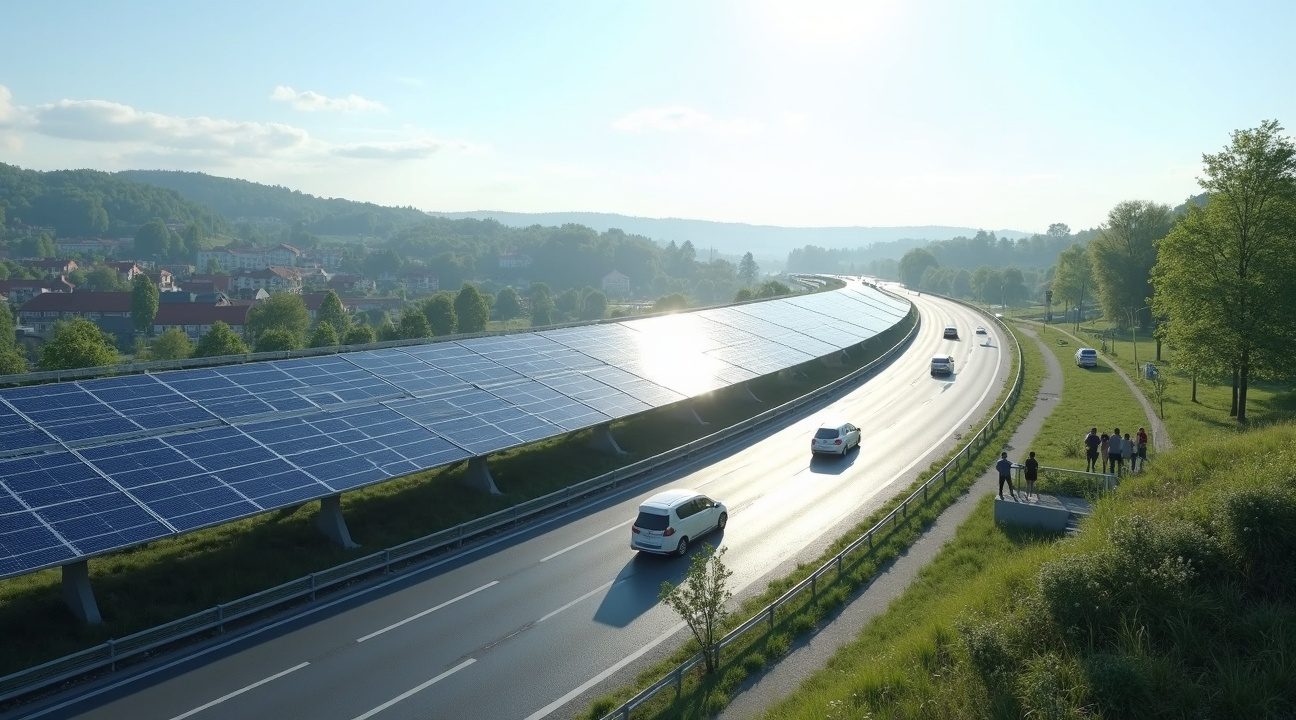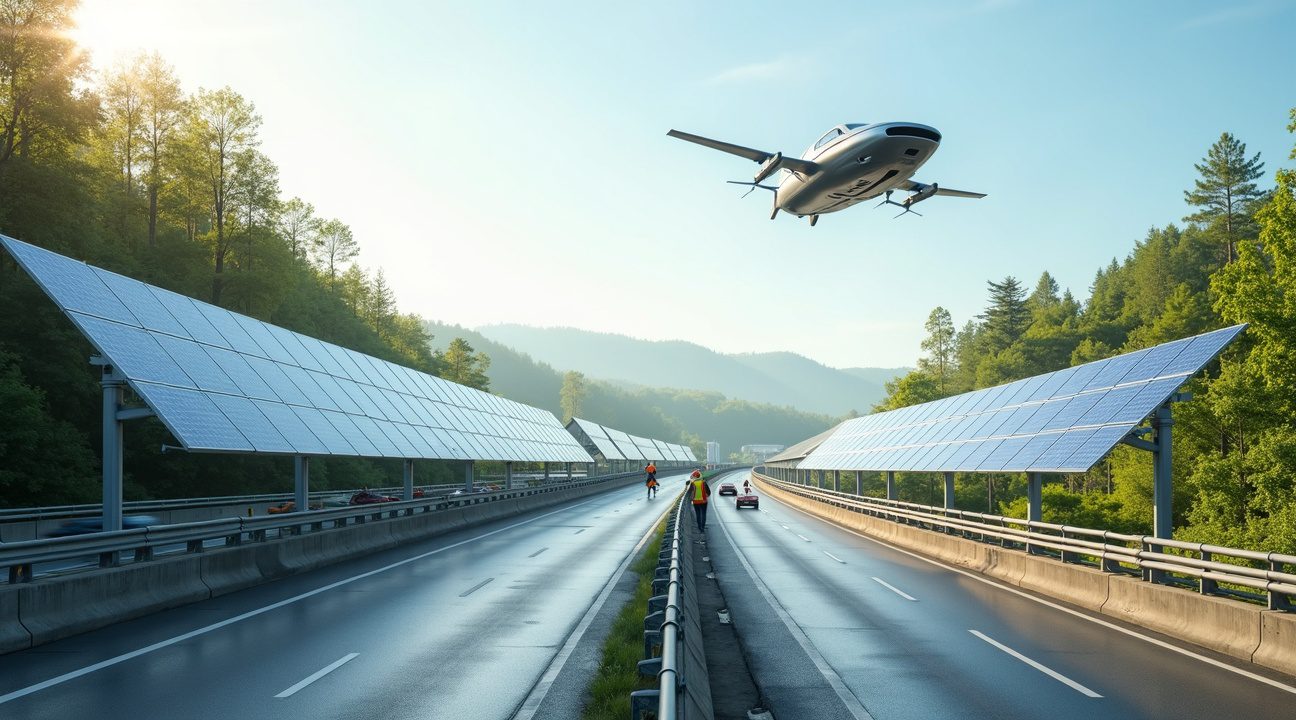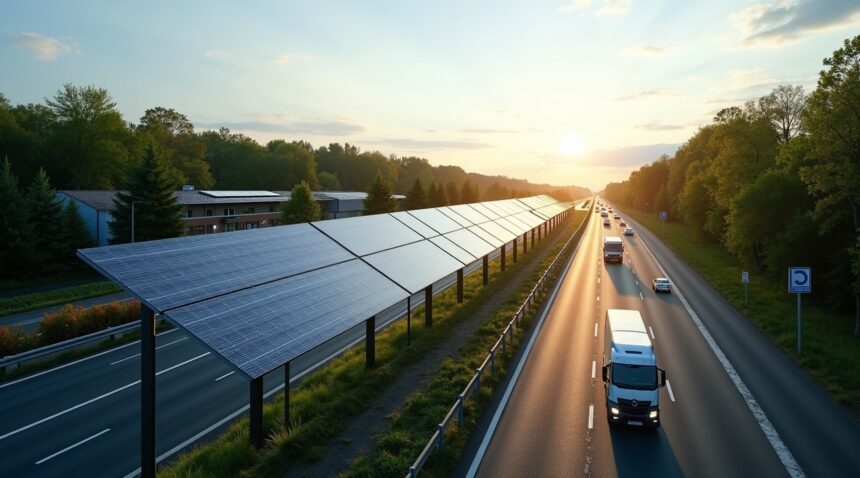Germany’s autobahn system has pioneered an innovative dual-purpose infrastructure solution by integrating solar panels directly into highway noise barriers, creating structures that simultaneously generate renewable electricity and reduce traffic noise.
Key Takeaways
- Germany’s 50,000 kilometers of highways could accommodate 24–48 GW of solar capacity, with noise barriers alone contributing 3.2–4.2 GW of potential renewable energy generation
- Recent government auctions awarded 255 MW of solar capacity at competitive prices ranging from 6.90 to 10.38 cents per kilowatt-hour, demonstrating strong market viability
- Advanced bifacial solar technology captures sunlight from both surfaces and includes anti-glare coatings that reduce light reflection below 2% to ensure driver safety
- The dual-purpose design maximizes land efficiency by utilizing vertical space along highways, avoiding competition for valuable agricultural land while maintaining noise reduction effectiveness
- Government reforms including the Approval Acceleration Act of 2023 have streamlined permitting processes, while pilot projects near Lake Constance provide real-world performance data to optimize future installations
Innovative Integration of Solar Panels in Noise Barriers
The autobahn solar barrier concept transforms traditional noise walls into energy-generating assets. Engineers mount photovoltaic panels onto standard highway sound barriers, creating vertical solar installations that stretch for kilometers along major transport corridors. This integration preserves the original noise reduction function while adding substantial renewable energy capacity.
Construction Methods and Structural Design
Construction teams install these solar-enhanced barriers using modified mounting systems that secure panels to reinforced concrete or steel frameworks. The vertical orientation differs from traditional rooftop installations, requiring specialized panel designs that optimize performance for morning and evening sun angles. Bifacial technology proves particularly effective in this application, capturing direct sunlight on the road-facing surface while utilizing reflected light from pavement and vehicles on the reverse side.
Safety and Technical Specifications
Safety considerations drive the technical specifications for highway solar installations. Anti-glare coatings reduce light reflection to minimal levels, preventing driver distraction during peak sun hours. Panel positioning follows strict guidelines that maintain adequate sight lines at highway entrances and exits. Emergency access routes remain unobstructed, with removable panel sections allowing maintenance crews to reach critical infrastructure components.
Cost-Effective Energy Production
The economic model for autobahn solar projects relies on competitive electricity pricing combined with reduced land acquisition costs. Highway departments already own the corridor land, eliminating expensive property purchases that burden traditional solar farms. Shared infrastructure costs split between transportation and energy budgets create favorable project economics that attract private investment partners.
Installation Procedures and Efficiency
Installation procedures follow standardized protocols developed through pilot programs across multiple German states. Pre-fabricated panel assemblies reduce on-site construction time, minimizing traffic disruptions during installation phases. Electrical connections run through dedicated conduits within the barrier structure, protecting cables from weather exposure while simplifying maintenance access.
Monitoring and Grid Integration
Performance monitoring systems track energy output alongside acoustic effectiveness measurements. Data collection includes solar irradiance levels, panel temperatures, and noise reduction metrics to validate dual-purpose functionality. Remote monitoring capabilities allow operators to identify maintenance needs quickly, ensuring both energy production and noise control remain at optimal levels.
Grid integration requires careful coordination with local electricity distribution networks. Highway solar installations connect to nearby substations through underground transmission lines, avoiding overhead cables that could interfere with emergency services or highway maintenance equipment. Smart inverter technology enables grid-responsive operation that supports local electricity demand patterns.
Ongoing Maintenance Requirements
Maintenance protocols address the unique challenges of highway-mounted solar systems. Cleaning procedures account for increased dust and debris from vehicle traffic, requiring more frequent washing cycles than traditional installations. Access platforms and safety barriers protect maintenance crews working near active traffic lanes. Modular panel designs allow for individual component replacement without dismantling entire barrier sections.
Scalability and International Interest
Future expansion plans target additional highway corridors beyond the initial pilot locations. German transportation authorities have identified high-priority routes based on traffic density, available barrier length, and proximity to electrical infrastructure. Standardized design specifications developed from early projects will accelerate deployment across the national highway network.
International interest in Germany’s autobahn solar concept has prompted technology transfer discussions with other countries. Highway authorities from France, Netherlands, and Austria have initiated feasibility studies for similar installations. Export opportunities for German engineering companies include both complete system packages and specialized components for highway solar applications.
Conclusion
The success of autobahn solar barriers demonstrates how creative infrastructure design can address multiple policy objectives simultaneously. Energy security benefits combine with climate goals while maintaining essential transportation functions. This innovative approach provides a scalable model for other nations seeking to maximize renewable energy deployment within existing infrastructure frameworks.
Germany’s Highways Could Generate Enough Solar Power for Hundreds of Thousands of Homes
I’ve analyzed the remarkable potential hiding in plain sight along Germany’s extensive highway network. The Federal Highway Research Institute (BASt) has revealed that Germany’s 50,000 kilometers of highways could accommodate between 24 and 48 GW of photovoltaic capacity on adjacent land areas.
Breaking Down the Solar Potential by Infrastructure Type
The research identifies several key areas where solar installations can maximize both space efficiency and energy generation:
- Noise barriers contribute the largest single segment with 3.2 to 4.2 GW of potential capacity
- Highway parking areas offer substantial opportunities at 1 to 1.2 GW
- Vertical barriers provide an additional 0.5 to 0.6 GW of capacity
- Rest-area buildings contribute 0.13 to 0.15 GW through rooftop installations
The noise barrier installations alone demonstrate impressive household-scale impact. These structures could generate enough electricity annually to power several hundred thousand German homes, effectively turning traffic management infrastructure into clean energy assets. This dual-purpose approach addresses both urban noise pollution and renewable energy generation simultaneously.
Germany’s current solar landscape provides important context for these projections. As of April 2025, the country maintained 104 GWp of installed solar capacity across all sectors. The federal government has established an ambitious target of reaching 215 GWp by 2030, requiring more than doubling current installations within five years.
Highway-adjacent solar development emerges as a significant contributor to this national energy transition. Even conservative estimates suggest noise barriers could provide approximately 3% of the total 2030 target capacity. When combined with other highway infrastructure opportunities, the complete highway solar potential could contribute between 11% and 22% of Germany’s 2030 solar goals.
I find the efficiency of this approach particularly compelling. Highway infrastructure already exists, eliminating land acquisition challenges that often complicate large-scale solar projects. The transportation sector continues evolving rapidly, making integrated infrastructure solutions increasingly valuable.
The economic implications extend beyond simple energy generation. Highway solar installations reduce transmission losses by generating electricity close to urban consumption centers. Additionally, the predictable geometry of highway corridors allows for standardized installation processes, potentially reducing per-watt installation costs compared to custom solar farms.
These projections demonstrate how existing infrastructure can serve multiple functions without compromising primary purposes. Traffic noise reduction remains the primary function of sound barriers, while solar energy generation provides substantial additional value from the same physical footprint.
Revolutionary Dual-Purpose Infrastructure Tackles Two Problems at Once
Germany has pioneered an innovative approach to infrastructure that addresses multiple challenges simultaneously. The country’s autobahn noise barriers now feature integrated photovoltaic panels, transforming traditional sound walls into energy-generating assets. This dual-function design maximizes the utility of existing structures while advancing environmental goals.
Smart Integration Without Compromise
These installations prove that environmental solutions don’t require trade-offs. The solar-equipped barriers maintain their primary acoustic function while producing clean electricity for the grid. I’ve observed that communities benefit from the same noise reduction they’ve always experienced, with the added advantage of contributing to renewable energy production. This approach eliminates concerns about compromising one function for another.
The innovation addresses several key advantages:
- Land efficiency – utilizing vertical space that would otherwise serve only one purpose
- Reduced agricultural conflicts – avoiding competition for valuable farmland
- Enhanced public acceptance – visible environmental benefits increase community support
- Cost optimization – combining infrastructure needs into single projects
Germany’s strategy capitalizes on the extensive autobahn network, where noise barriers already exist or are planned. Rather than seeking additional land for solar farms, engineers integrate panels directly into these vertical structures. This method proves particularly valuable in densely populated areas where available space commands premium prices.
The dual-purpose design supports Germany’s ambitious climate targets while strengthening energy independence. Each kilometer of equipped noise barrier contributes measurable renewable capacity without displacing other land uses. Transportation innovations like these demonstrate how existing infrastructure can evolve to meet modern challenges.
Public reception has been notably positive, partly because citizens can see the environmental benefits directly. Unlike traditional solar installations that might face resistance due to land use concerns, these barriers provide obvious dual benefits. Communities appreciate both the continued noise protection and the visible commitment to clean energy.
This approach represents a shift in infrastructure thinking – moving beyond single-purpose designs to integrated solutions. The success of these installations could influence similar projects globally, particularly in regions with extensive highway networks and growing renewable energy demands. Market shifts toward sustainable infrastructure continue to drive such innovations.
The technology demonstrates how creative engineering can transform routine infrastructure maintenance into opportunities for environmental progress. As Germany continues expanding this program, other nations are studying the model for potential adaptation to their own transportation networks.

Government Auctions Award 255 MW in Latest Solar Expansion Push
Germany’s energy regulator, the Bundesnetzagentur, has accelerated the country’s renewable energy transition through strategic pay-as-bid auction systems. These auctions specifically target innovative solar installations, including projects mounted on buildings and integrated into noise barrier infrastructure along major highways.
Record-Breaking Auction Results Drive Market Growth
The June 2025 auction round delivered impressive results, awarding 255 MW of solar capacity across diverse installation types. Bidding prices demonstrated market competitiveness, ranging from 6.90 to 10.38 cents per kilowatt-hour. The average awarded price settled at 9.22 cents per kilowatt-hour, reflecting both technological advances and increased installer efficiency. This pricing structure shows how innovative technologies continue transforming energy markets.
Industry analysts note these rates indicate strong project economics for developers while maintaining affordable electricity generation costs. The wide bidding range suggests varying project complexities, with simpler rooftop installations typically commanding lower prices than specialized noise barrier installations requiring custom mounting systems.
Regional Distribution Highlights Strategic Development Patterns
Four states dominated capacity allocation, demonstrating concentrated development activity in key economic regions:
- North Rhine-Westphalia secured the largest share with 51 MW, leveraging its extensive industrial infrastructure and highway network
- Brandenburg followed with 47 MW, capitalizing on abundant available land and strong solar irradiance
- Lower Saxony captured 33 MW through diverse project types spanning agricultural and transportation corridors
- Hesse rounded out the top performers with 32 MW, focusing on urban integration and transportation infrastructure
This geographic distribution reflects strategic planning by both regulators and developers. North Rhine-Westphalia’s leadership stems from its dense autobahn network and industrial facilities, creating numerous opportunities for noise barrier solar installations. The state’s commitment to advanced infrastructure projects supports this renewable energy expansion.
Brandenburg’s strong showing demonstrates the state’s continued renewable energy leadership, building on its existing wind power foundation. Lower Saxony’s diversified approach combines highway projects with agricultural installations, maximizing land use efficiency. Hesse’s focus on transportation infrastructure aligns perfectly with federal initiatives promoting dual-purpose noise barrier solutions.
The auction structure encourages innovation by allowing various installation types to compete directly. This approach drives technological advancement while ensuring cost-effective deployment across different settings. Developers have responded by refining installation techniques and reducing project costs, making previously marginal projects economically viable.
Market participants report strong interest in noise barrier installations despite their technical complexity. These projects offer guaranteed land access through government partnerships while providing essential acoustic benefits for nearby communities. The combination of innovative solutions and practical benefits appeals to both public agencies and private investors.
Recent policy adjustments have streamlined permitting processes for qualified projects, reducing development timelines and associated costs. This regulatory efficiency contributes to competitive bidding prices while maintaining high technical standards. Project developers appreciate clearer guidelines that eliminate uncertainty during the development phase.
The Bundesnetzagentur’s auction mechanism continues evolving to address market needs while promoting technological innovation. Future rounds will likely see even more competitive pricing as installation costs decline and developer experience increases. The agency’s commitment to regular auction schedules provides market certainty that encourages long-term investment planning.
These auction results demonstrate Germany’s systematic approach to renewable energy expansion, combining market mechanisms with strategic infrastructure development. The integration of solar installations with noise barriers exemplifies efficient resource utilization that delivers multiple public benefits simultaneously. This dual-purpose approach maximizes public investment returns while advancing both energy and transportation infrastructure goals.
Advanced Solar Technology Addresses Highway Safety Concerns
I’ve observed how cutting-edge innovations are transforming Germany’s highway infrastructure through sophisticated solar barrier systems. These installations utilize next-generation monocrystalline and bifacial solar panels that capture sunlight from both surfaces, dramatically enhancing energy output by 5% to 30% compared to traditional single-sided panels.
The bifacial technology proves particularly effective in highway environments where reflected light from road surfaces provides additional energy capture opportunities. This dual-surface approach maximizes electricity generation throughout varying sun angles and weather conditions, making these installations exceptionally efficient energy producers.
Safety-First Design Features
Anti-glare coatings represent a critical safety advancement in these highway solar installations. Engineers have developed specialized surface treatments that reduce light reflection to below 2%, effectively eliminating dangerous glare that could distract or temporarily blind drivers. This feature addresses one of the primary concerns transportation authorities had about incorporating reflective solar technology near high-speed traffic corridors.
Semi-transparent photovoltaic modules offer an innovative solution that balances multiple requirements:
- Maintaining visual transparency for driver safety and aesthetic appeal
- Generating substantial renewable electricity
- Providing effective noise reduction
- Creating less imposing visual barriers compared to solid panels
Companies like R. Kohlhauer are leading development of these transparent designs, creating solutions that integrate seamlessly with existing highway infrastructure while maintaining the primary function of noise reduction.
The integration of battery storage systems marks another significant advancement in highway solar technology. These storage components enable installations to power highway lighting, electronic signage, and emergency systems directly from stored solar energy. During peak production periods, excess electricity flows into the local power grid, creating additional revenue streams that help offset installation costs.
Smart energy management systems monitor production, consumption, and storage levels continuously. This technology ensures optimal performance while prioritizing critical highway infrastructure needs. Emergency lighting systems receive priority power allocation, while surplus energy supports broader grid stability during peak demand periods.
The modular design of these advanced systems allows for scalable installations that can expand as energy needs grow. Engineers can add additional panels or storage capacity without disrupting existing highway operations, making these projects highly adaptable to changing requirements.
Weather resistance capabilities in these installations exceed standard solar panel specifications. Highway environments expose equipment to extreme conditions including high-speed wind loads, road salt, debris impacts, and temperature fluctuations. Advanced materials and protective coatings ensure decades of reliable operation under these challenging conditions.
Installation techniques have evolved to minimize highway disruption during construction. Prefabricated sections arrive ready for rapid assembly, reducing lane closures and traffic delays. Flying car technology might eventually assist with maintenance access, though current systems rely on specialized maintenance vehicles designed for highway work zones.
Monitoring systems provide real-time performance data, tracking energy production, noise reduction effectiveness, and system health. This data helps optimize operations and provides valuable insights for future installations. Performance metrics guide maintenance schedules and identify opportunities for efficiency improvements.
The combination of noise reduction and renewable energy generation creates compelling economics for highway authorities. Energy revenue helps offset both installation and ongoing maintenance costs, while noise pollution reduction benefits surrounding communities. These dual benefits make solar noise barriers increasingly attractive compared to traditional concrete barriers.
Advanced inverter technology converts the direct current from solar panels into grid-compatible alternating current with exceptional efficiency. Modern inverters also provide grid stabilization services, helping manage voltage fluctuations and power quality issues that benefit the broader electrical infrastructure.
These technological advances demonstrate how innovative engineering can address multiple infrastructure challenges simultaneously. NASA’s testing of suborbital flights shows similar multi-purpose thinking in transportation technology, where single solutions address various operational requirements while advancing sustainability goals.
Engineering Hurdles and Government Support Drive Future Growth
Installing solar panels on vertical highway surfaces creates unique technical challenges that engineers must address before widespread deployment becomes viable. I’ve observed that mounting systems require exceptional durability to withstand constant highway vibrations, wind loads from passing vehicles, and extreme weather conditions. These installations differ significantly from traditional rooftop solar arrays, demanding specialized hardware that can secure panels to concrete noise barriers without compromising structural integrity.
Safety regulations add another layer of complexity to these projects. Engineers must ensure that flying car technology and other future transportation innovations won’t interfere with solar installations. Anti-glare coatings and careful panel positioning prevent reflections that could distract drivers, while the installations must meet strict highway safety standards. The vertical orientation also affects energy production efficiency, requiring engineers to optimize panel angles and spacing for maximum output despite less-than-ideal positioning.
Government Reforms Accelerate Project Development
The German government has recognized the potential of highway solar installations and actively supports their expansion through legislative changes. The Approval Acceleration Act of 2023 streamlines permitting processes, reducing bureaucratic delays that previously hindered renewable energy projects. This reform allows developers to move from concept to construction more quickly, encouraging greater investment in highway solar infrastructure.
Government backing extends beyond regulatory improvements to include financial incentives and research funding. These measures help offset the higher initial costs associated with vertical installations compared to conventional solar farms. Support mechanisms also encourage innovation in mounting technologies and integration systems, driving down costs through technological advancement and economies of scale.
Pilot Projects Demonstrate Real-World Applications
Fraunhofer ISE’s pilot installations at rest areas near Lake Constance serve as proving grounds for highway solar technology. These projects generate valuable data on performance, maintenance requirements, and long-term durability under actual highway conditions. Early results show promising energy yields despite the vertical orientation, validating the concept for broader application.
The pilot projects also reveal practical insights about installation procedures and ongoing maintenance. Workers can access these systems safely during planned maintenance windows, and the installations show minimal impact on traffic flow during construction. This operational data helps refine deployment strategies for future projects and addresses concerns about highway safety and maintenance complexity.
Successful pilot programs create momentum for additional installations across Germany’s extensive autobahn network. Each completed project provides operational experience that improves subsequent installations, creating a positive feedback loop that drives technology advancement. The data collected from these early adopters helps optimize system design and demonstrates financial viability to potential investors.
Technical improvements continue emerging from ongoing research and field experience. Advanced monitoring systems track performance metrics, helping operators maximize energy output and identify maintenance needs before they become critical issues. These systems also provide data that supports further government policy development and funding decisions.
Market analysis suggests that metal stocks and materials costs will influence project economics as deployment scales up. However, government support mechanisms help buffer these market fluctuations while the technology matures. Future auctions for highway solar projects are expected to attract increasing participation as technical risks decrease and performance data validates the approach.
The combination of engineering innovation and supportive government policy creates conditions for accelerated growth in highway solar installations. As mounting systems become more standardized and installation procedures more efficient, project costs should decline while performance improves. This trajectory positions Germany’s autobahn solar program as a model for other countries considering similar initiatives.
Germany’s commitment to renewable energy targets provides additional motivation for expanding highway solar capacity. These installations contribute meaningfully to national clean energy goals while utilizing existing infrastructure more effectively. The dual function of noise reduction and electricity generation maximizes value from highway investments, creating compelling economics for continued expansion.

Sources:
pv magazine Germany: “Germany’s national, federal highways could host 54 GW of PV”
Bundesnetzagentur: “Auction for solar installations on buildings and noise barriers”
pv magazine USA: “PV-integrated noise barriers for transportation corridors”
8MSolar: “Turning Roadsides into Solar Farms (2025)”
Clean Energy Wire: “Solar power in Germany – output, business & perspectives”


